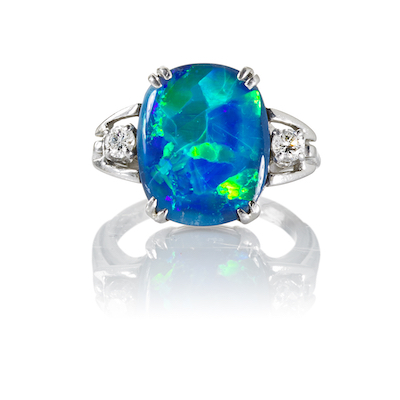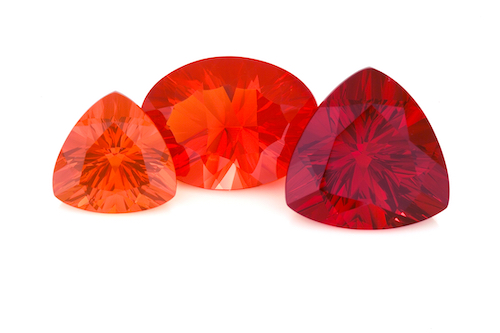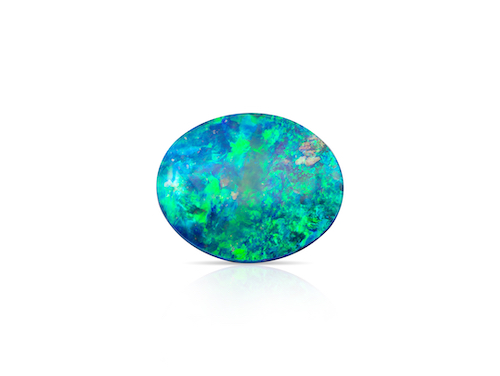
October's birthstone is surely one of the most fascinating. After all, there is no other gemstone in which one might see the iridescent wing of a butterfly, a landscape or a display of fireworks. Thought by the Romans to represent love and hope and by the Greeks as a protector from illness, it's a perfect gift to give to a loved one.
Most opal is found in Australia but there are other sources too, including Mexico, Peru, Ethiopia and even Cornwall. The most widely found have a white body colour, with a black body colour being rarer and most frequently found in Lightning Ridge, Australia. Boulder opal is another variety, displaying the colours of the earth interrupted by flashes of the spectrum. Mexican fire opal is a translucent orange, water opal is colourless and both can, but don't always, demonstrate a play of colour.

Gemmologically speaking, opal is a silica. The structure is made up of spheres of silica (as well as water trapped in the structure) stacked in grids and rows, like marbles in a box. Depending on the diameter of the silica spheres, light that enters the stone and travels between the spheres is refracted, or bent, to varying degrees, bouncing back to the eye in flashes, or play, of colour. The smaller spheres result in red flashes, the rarest colour to be seen in opal. It is formed when rainwater soaked through dry ground, pulling dissolved silica along with it. With drying out comes a degree of evaporation and the solidified remaining silica becomes opal within cracks of rock.
Black opal tends to be the most valuable and sought after but the key to the value of any opal is the quality of the play of colour. The more intense the colour play the better and red flashes are the rarest, and thus those stones the most valuable. Opals can, along with other gemstones, have inclusions, sometimes termed as flaws. It could be a patch of mother rock, or a dark shadow through the white body colour, but the absence of these features would be most desirable and increase the value. The cut is crucial in enabling the stone to display its play of colour and of course the carat weight also impacts on the value of the opal.
Opal has always been prized, including by the Romans who believed it to be the most impressive gem as it demonstrates the colours of many other gemstones. Opal's unfair reputation for being unlucky sadly originates in the country I live in, Scotland, with Sir Walter Scott's novel 'Anne of Geierstein', in which Lady Hermione wears an opal in her hair, the colour of the opal changing with her mood - as a result it is sprinkled with holy water, loses its lustre and Lady Hermione becomes ill and ends up only as a pile of ashes on her bed. Sir Walter Scott is clearly not very popular with the opal mining community as a result of this. Thankfully Queen Victoria, following on from the 1870 discovery of a huge opal deposit in Australia, at that time British territory, wore opals to help dispel the myth and presented opals to friends and each of her five daughters. I am also happy to guarantee that wearing an opal will not result in being found on your bed as a pile of ash. An opal miner from Lightning Ridge once told me that his answer to being asked if opal was unlucky was always 'Only if you can't afford one!'. It's important to treat opals with care and store them safely - never use ultrasonic cleaners or jewellery cleaning fluids on them. Avoid detergents and chemicals. Keeping them in a safe or safety deposit box for extended periods is also bad for them. Sadly, I've seen the results of this sort of storage on opal. They key is you own a beautiful opal - insure it properly and then wear and enjoy it - that's what jewellery is there for!
Her Majesty Queen Elizabeth II owns a necklace and earrings known as the Andamooka suite. The opal in the necklace weighs over 200cts and was presented to her in 1954 on behalf of the people of South Australia.

Opals can be treated to alter their appearance, for example a white opal may be dyed black to 'increase the value' and deceive a buyer. This sort of treatment must be declared to a buyer and only emphasises the need to purchase from a trusted source and have insurance valuations carried out by a qualified gemmologist who would recognise any such treatments. Opals can also be set into 'doublets' or 'triplets' using other materials to give the impression of a solid opal. They are significantly less valuable than a solid opal and again, it should be made clear to you exactly what you are buying.
Please do contact me if you are interested in purchasing opals, opal jewellery, or require an insurance valuation.
